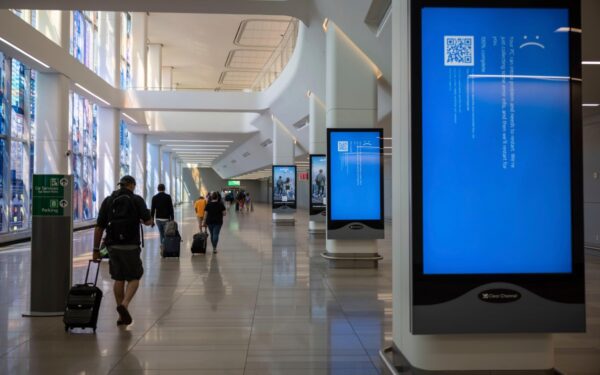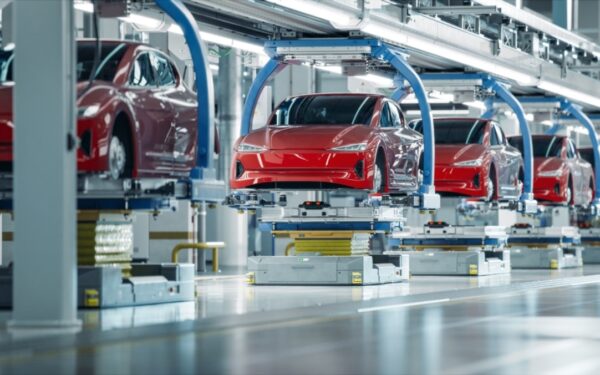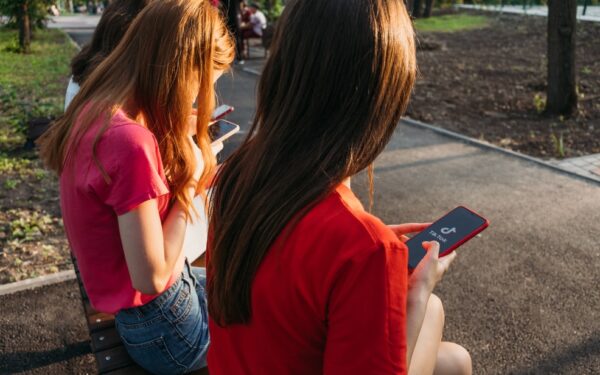This is Iain Martin’s weekly newsletter. To receive it each Friday become a Reaction subscriber.
I am in Venice and have seen the future. No, I have not been made dizzy by drinking too much perfectly chilled prosecco. Imbibing the view of the Venetian vista in the sun is enough on its own to make anyone sensate feel light-headed. And then there are those elegant wooden boats pottering about on the water. And the food. And the churches. And the art. And the August crowds being at some distance because we’re on a tranquil island where my hosts are holding a conference.
The Alpine Fellowship is an exemplary non-profit organisation dedicated to promoting culture and the arts. Founded by Jacob Burda, a German philosopher based at Oxford, and Alan Lawson, a British artist based in Switzerland, it is in its fifth year. They identify gifted young artists and fund a range of prizes.
Once a year, now in Venice at the Cini Foundation, they draw together participants from academia, the arts, business, and even the odd journalist, to talk and share ideas in a respectful spirit that makes a refreshing and uplifting contrast to the frenetic, angry tone of much contemporary discourse. Their gathering – creating a “dialogue between the disciplines” – is outstanding. In the digital age it is the antidote to too much time spent on social media.
I’m here to take part in a small way. While no-one at the end of a hard week wants to hear about my Venetian perambulations to a former monastery by water taxi, I did nearly fell in at one point, if that make you feel better.
But in among the lectures and panel discussions was a presentation of such power that it all but rocked me back on my feet. What with me being a cynical old British hack, this doesn’t happen very often.
Nonny de la Pena is one of the leading developers of virtual reality. Her project on Greenland and melting glaciers premieres next week at the Venice Film Festival. (No, calm down climate change sceptics, this is not a newsletter about global warming.)
If you think of virtual reality as some distant possibility, a tech nerd fixation with silly goggles that will have little impact on real life even if it does arrive, then it might be time to recalibrate your thinking, adjust your headset and pay attention.
There is a race on in entertainment and sport to make Virtual Reality (VR) a reality that hundreds of millions of consumers will pay to set up in what used to be their TV room. The headsets are improving and the technology is rapidly coming down in price. If you know a youngster immersed in gaming or Minecraft (creative, important, when not done to the exclusion of all other life) then you can probably see the possibilities when that fuses with a VR headset. Trying to figure out how to arrest this development is pointless. The technology exists and a whole new generation is already used to playing in a virtual world. Get used to it.
Where the American Nonny de la Pena’s work differs is that she is a leading exponent of developing VR for news journalism, or what as an old fuddy duddy words journalist I still like to think of, rather quaintly, as real life. Her company has already worked on pioneering projects for The Wall Street Journal and the New York Times.
Among her projects as a producer and director are a recreation of the US camp at Guantanamo Bay, studies of a death in custody and a report on the war in Syria. An excerpt of the latest Greenland film, or experience, was ready to try.
How to describe it? Put on the headset and headphones and you are immersed and surrounded. Unlike with the rickety early commercial versions produced by others, in this set-up you can walk around, or crouch to go below the waterline in order to see the glacier close up. On the deck of a ship surveying Greenland, and then a plane flying over it, you have 360 degree vision. The narrators stand alongside the viewer. In this case, they are “scanned” representations of two scientists and as the viewer moves the angle and picture and sound change seamlessly.
If the viewing experience lacks for now the crispness of 4K television, the quality is impressive. When the race for development and investment is won, this will have endless applications. Think of visualising and experiencing sport, or battles, or even financial markets in realtime, or recreating historical experiences.
We are going to end up soon with some downright weird mash-up experiences when the technology gets good enough and affordable, which it will. Some of it we will watch, but we’ll have the option to take part. Play guitar and of an evening want to accompany the Beatles in the studio at Abbey Road? It will be possible in VR, probably for a fee. Fancy simulating being at the top of Mount Everest? Tick. Regret that Laurel and Hardy never made a feature film with Charlie Chaplin, and want to put them together with a specially crafted script? Someone will make it possible. Want to paint and have a beer with a re-imagined version of the rock’n’roll bad boy of art Caravaggio? You will be able to. Let’s not even mention pornography.
In terms of news and reporting what actually happened, it will become possible to be inside the story, standing in real footage with the sound all around you. The camera on the ground will film every angle and stitch it together in a few minutes. Google Earth already has a version of that on its Street View app. Think about the potential for a second, with war coverage or terrorism or a disaster. In the right hands this presents an extraordinary new way for stories to be told.
But as Nonny de la Pena acknowledges, it raises profound and complex ethical questions about what is shown and the emotional manipulation of the viewer that goes well beyond standard Facebook fraud posts. The VR experience is better than cinema or TV but it blurs the line between self and other, and between real and unreal.
In an effort to resolve some of these questions, and hopefully to set standards, a commission has been established in the US on truth in news. Trust in news organisations, in authority in general, has been declining since the 1970s. Now, many millions of (armed) Trump supporters believe what their hero says about the mainstream media. The mainstream media duly feeds their anger by exaggerating genuine grievances and giving them a cartoonish treatment. It is a mess.
In Britain too a lot has been written of late about this being the post-truth era, meaning objective truth is supposedly eclipsed by emotion and fakery. Three books have been published in the UK on the subject. Matthew d’Ancona, Evan Davis and James Ball have each tackled post-truth seriously in the wake of Donald Trump and the spread of fake news.
What is apparent to me, I regret to say, is that we are only at the beginning. Trump is far from the peak of this process. We’re in the foothills of the digital revolution and he is an early indicator of what is coming in western culture, if we’re not careful. You think the line between truth and a lie in politics and media is confused now? Wait a few years.
The single biggest open question about VR in news relates to verification and authentication when millions will watch. A responsible journalist will use real footage to create a VR film or participatory event, and cite public source material, and hopefully use it all responsibility to show what happened and to tell a story.
Thank goodness everyone is so responsible and civic-minded and there isn’t a shady, secretive network of people beavering away in the shadows creating fake news, some of them in the vicinity of the former Soviet Union possibly egged on by the Kremlin.
Oh, hold on, there is exactly that. As America discovered in the US election last year, fakery spreads fear and confusion. Such post-modern digital chicanery did not “steal” the election. Hillary Clinton handed it to Donald Trump.
However, the fake memes mingled with half-truths, combined with hacking and leaking, did deepen the climate of chaos and distrust around Clinton’s candidacy. The so-called “Pizzagate” story is one such example, a mad tale believed by conspiracy theorists to the extent that one Trump supporter turned up at the Washington pizza restaurant with a gun. There was not a child abduction ring run by Democrats in the basement, it turned out.
Imagine the potential for faking future scandals, whether it is in immersive VR, or as conventional footage deploying some of the same techniques, in which a conspiracy theorist’s dreams come true. Imagine a walking, talking, scanned copy of Hillary Clinton, or some other anti-populist, or an aide, made to say or do whatever the creator of the footage wanted.
How will it be checked? Who will control the verification on what is real footage and a real event and what is not? How will leaders, and eventually citizens, establish the difference between what is real and what looks real but was made by a trickster or a foreign government when it all seems authentic and denials are disbelieved?
Up-market consumers are worried and they are now prepared to pay for what is genuine and trusted, but that discipline may not apply in the mass market, with obvious benefits for populist politicians and trainee demagogues.
Although conventional publishers and journalists are flawed, we are constrained by the laws of libel in print and online and mostly try to get it right, unlike the shadowy producers of authentic-looking propaganda that can then be dispersed unchecked on Facebook and Google, both pretending not to be the publishers of this stuff when that is just what they are.
Twitter’s answer – not much, but better than nothing – is a blue tick which verifies users as being who they say they are. There’s a thought. We may all need the equivalent, a life tick or time stamp proclaiming “yes this is me, I endorse this message”, as a basic requirement for doing anything such as posting on social media, or making a payment. I’m only half-joking. I haven’t been drinking any prossecco or red wine yet at the Alpine Fellowship or in Harry’s Bar. Not yet. That comes this evening.




